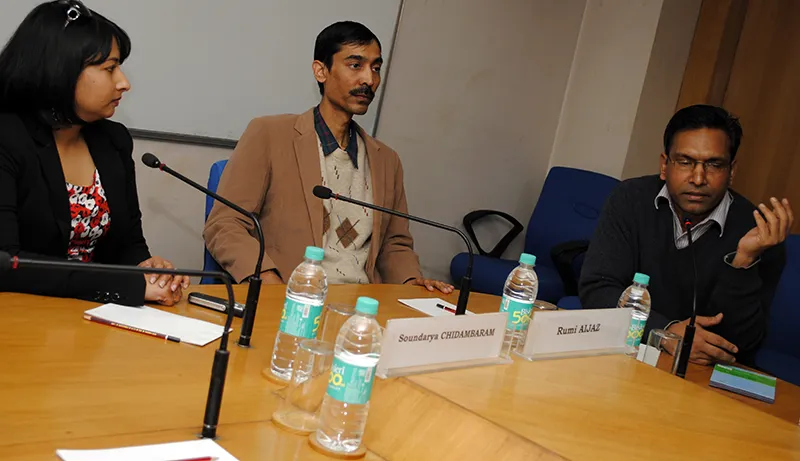-
CENTRES
Progammes & Centres
Location
Globally, there is an upsurge of sectarian movements and informal community-based organisations that affect the daily lives of the urban poor in the way they provide for their need of tangible goods and services.

Globally, there is an upsurge of sectarian movements and informal community-based organisations that affect the daily lives of the urban poor in the way they provide for their need of tangible goods and services. This was the key message emerged from a talk on "Sectarianism in the Neoliberal City: India’s Urban Poor and the Politics of Welfare", by Dr. Soundarya Chidambaram, a Charles & Amy Scharf Postdoctoral Fellow at Department of Political Science, John Hopkins University. The talk, organised by Observer Research Foundation, Delhi on 14 January, was moderated by Dr. Rumi Aijaz, Senior Fellow, ORF.
Dr. Soundarya Chidambaram began her presentation by pointing out that the urban poor often appear voiceless in making effective claims on the functioning of the State, thus keeping them away from the mainstream political discourse. She emphasised that there hasn’t been any serious exploration in studying the rise of the Hindu nationalist movement as a successful social movement.
Presenting the results of her extensive fieldwork in the two states of Karnataka (Bengaluru) and Tamil Nadu (Chennai), Dr. Soundarya Chidambaram focused on the rise of Rashtriya Swayamsevak Sangh (RSS) as the ideological parent, with the country seeing the urban poor being drawn into the networks of radical sectarian organisations.
She argued on examining two primary questions (1) ’Why welfare provisions gained momentum since the 1990s? (2) ’Why is it that the RSS has seen success only in some states?’ She went on to describe the dynamic organisational strategies adopted by RSS over the period from 1997 to 2009, which ultimately led it to legitimise itself with the micro-politics at play in the lower levels in the society. Neo-liberal reforms were seen in the way the sectarian movement entrenched itself in public spaces created by the inefficiency of governmental policies. This is when the urban poor felt the impact of no-access to the social reforms, keeping in mind that the middle class had already opted itself out of the system for it could reasonably afford the services provided by the private sector. She explained this scenario with the increasing reliance of the urban poor on the non-state actors. On the question of the failure of Seva Bharati, she reasoned out that it was due to the presence of pre-existing civil societies and a network of clientelism that was further backed by strong community organizations in those states.
According to Dr. Soundarya Chidambaram, Bengaluru has witnessed a very streamlined associational activity by the community organisations which is, however, biased towards the economic, social and political advancement of the middle class exclusively. This is in sharp contrast to her findings in Chennai where the urban poor is very vocal and assertive in the demand for social service delivery, thus reflecting a high social provisioning of educational and health-care services by networks other than the RSS initiatives. Overall, the presence of civil societies explains the situational difference in the relationship between the government’s decision-making and the local patrons, whose role is not nurtured in the political arena in Chennai. This is when we need to take a pause and analyse how rich associations gain tremendous political leverage by providing resources in the local neighborhoods, she argued.
Earlier, while introducing the speaker, Dr. Rumi Aijaz touched on the reality of urbanisation in India, its stress and strains. He spoke about nature of migration and status of urban poor vis-à-vis various agencies and provisions available in urban spaces.
The talk was followed by a question and answer session. Dr. Niranjan Sahoo, Senior Fellow, ORF, drew the speaker’s attention to the importance of ideologies of such associations when they go about projecting their agendas to the targeted segments of the society. He went on to mention that Municipal level elections act as a barometer to judge the performance of the civil society organisations and therefore, their role cannot be underestimated; as was witnessed in the recent affair of the Aam Aadmi Party wherein they campaigned mostly amongst the urban poor. Appreciating this line of thinking, Dr. Soundarya Chidambaram said that the rising middle class’s discontent against the inefficient services of the government enabled the AAP to capture the niche very well. This should work as a wake-up call for the mainstream parties.
On the question of the future of sectarian rise in other states like Delhi and Kolkata, Dr. Soundarya Chidambaram was confident of the fact that as regards the ideological support to such organisations, one can surely be optimistic in the short run.
To a question on the role of church welfare associations vis-à-vis the informal community organisations, she said that the RSS certainly implemented a carefully thought-out agenda by adopting a range of welfare ideologies that had been in place earlier too, in order to push its way forward. She added that it is indeed a happy marriage for RSS, owing to the simple reason that social movements remain even if political power withers away.
Responding to a query about the level of competition to such associations from other non-state actors, she said that this is where political strategies of rich associations come into play because other NGOs are not able to deliver to the extent these organisations do. This in turn provided for a strong community entrenchment that RSS has been able to sustain.
(This report is prepared by Nidhi Singla, Research Intern, Observer Research Foundation, Delhi)
The views expressed above belong to the author(s). ORF research and analyses now available on Telegram! Click here to access our curated content — blogs, longforms and interviews.